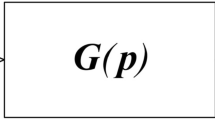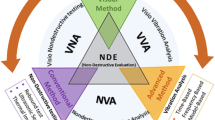Abstract
Damage is defined as changes to the material and/or geometric properties of a structural system, comprising changes to the boundary conditions and system connectivity, adversely affecting the system’s performance. Inspecting the elements of structures, particularly critical components, is vital to evaluate the structural lifespan and safety. In this study, an optimization-based method for joint damage identification of moment frames using the time-domain responses is introduced. The beam-to-column connection in a metallic moment frame structure is modeled by a zero-length rotational spring at both ends of the beam element. For each connection, an end-fixity factor is specified, which changes between 0 and 1. Then, the problem of joint damage identification is converted to a standard optimization problem. An objective function is defined using the nodal point accelerations extracted from the damaged structure and an analytical model of the structure in which the nodal accelerations are obtained using the Newmark procedure. The optimization problem is solved by an improved differential evolution algorithm (IDEA) for identifying the location and severity of the damage. To assess the capability of the proposed method, two numerical examples via different damage scenarios are considered. Then, a comparison between the proposed method and the existing damage identification method is provided. The outcomes reveal the high efficiency of the proposed method for finding the severity and location of joint damage considering noise effects.
Similar content being viewed by others
References
Seyedpoor S M, Yazdanpanah O. An efficient indicator for structural damage localization using the change of strain energy based on static noisy data. Applied Mathematical Modelling, 2014, 38(9–10): 2661–2672
Nanthakumar S S, Lahmer T, Zhuang X, Zi G, Rabczuk T. Detection of material interfaces using a regularized level set method in piezoelectric structures. Inverse Problems in Science and Engineering, 2016, 24(1): 153–176
Yun C B, Yi J H, Bahng E Y. Joint damage assessment of framed structures using a neural networks technique. Engineering Structures, 2001, 23(5): 425–435
Ritdumrongkul S, Fujino Y. Identification of the location and level of damage in multiple-bolted-joint structures by PZT actuator-sensors. Journal of Structural Engineering, 2006, 132(2): 304–311
Dilena M, Morassi A. Vibrations of steel-concrete composite beams with partially degraded connection and applications to damage detection. Journal of Sound and Vibration, 2009, 320(1–2): 101–124
Xu B, Tan T, Hao H. Local shear connectors damage detection for a concrete-steel composite beam using acceleration time series. In: Proceedings of the 12th Biennial International Conference on Engineering, Construction, and Operations in Challenging Environments. Honolulu: ASCE, 2010
Labuz E L, Chang M, Pakzad S N. Local damage detection in beam-column connections using a dense sensor network. In: Proceedings of Structures Congress 2010. Orlando: ASCE, 2010
He K, Zhu W D. Structural damage detection using changes in natural frequencies: Theory and applications. In: Proceedings of the 9th International Conference on Damage Assessment of Structures (DAMAS 2011). Oxford: IOP Publishing Ltd, 2011
Hegenderfer J, Atamturktur S, Gillen A. Damage detection in steel structures using bayesian calibration techniques. In: Conference Proceedings of the Society for Expeimental Mechanics Series. New York: Springer, 2012
Yang J N, Xia Y, Loh C H. Damage identification of bolt connections in a steel frame. Journal of Structural Engineering, 2013, 140: 1–9
Dackermann U, Li J, Samali B. Identification of member connectivity and mass changes on a two-storey framed structure using frequency response functions and artificial neural networks. Journal of Sound and Vibration, 2013, 332(16): 3636–3653
Ho D D, Ngo T M, Kim J T. Impedance-based damage monitoring of steel column connection: Numerical simulation. Structural Monitoring and Maintenance, 2014, 1(3): 339–356
Nanda B, Maity D, Maiti D K. Modal parameter based inverse approach for structural joint damage assessment using unified particle swarm optimization. Applied Mathematics and Computation, 2014, 242: 407–422
Yin T, Jiang Q H, Yuen K V. Vibration-based damage detection for structural connections using incomplete modal data by Bayesian approach and model reduction technique. Engineering Structures, 2017, 132: 260–277
Dinh-Cong D, Ho-Huu V, Vo-Duy T, Ngo-Thi H Q, Nguyen-Thoi T. Efficiency of Jaya algorithm for solving the optimization-based structural damage identification problem based on a hybrid objective function. Engineering Optimization, 2018, 50(8): 1233–1251
Dinh-Cong D, Dang-Trung H, Nguyen-Thoi T. An efficient approach for optimal sensor placement and damage identification in laminated composite structures. Advances in Engineering Software, 2018, 119: 48–59
Dinh-Cong D, Nguyen-Thoi T, Nguyen D T. A FE model updating technique based on SAP2000-OAPI and enhanced SOS algorithm for damage assessment of full-scale structures. Applied Soft Computing, 2020, 89: 106100
Katkhuda H N, Dwairi H M, Shatarat N. System identification of steel framed structures with semi-rigid connections. Structural Engineering and Mechanics, 2010, 34(3): 351–366
Filho M S, Guimaraes M J R, Sahlit C L, Brito J L V. Wind pressures in framed structures with semi-rigid connections. Journal of the Brazilian Society of Mechanical Sciences and Engineering, 2004, 26: 180–189
Clough R W, Penzien J. Dynamics of Structures. New York: McGraw-Hill, 1993
Song Z, Su C. Computation of Rayleigh damping coefficient for the seismic analysis of a hydro-powerhouse. Shock and Vibration, 2017, 2: 1–11
Standard No. 2800. Iranian Code of Practice for Seismic Resistant Design of Buildings. Tehran: Road, Housing and Urban Development Research Center, 2015
Manie J, Kikstra W P. DIANA Finite Element Analysis User’s Manual Release 10.0, 2015
Seyedpoor S M, Shahbandeh S, Yazdanpanah O. An efficient method for structural damage detection using a differential evolution algorithm-based optimization approach. Civil Engineering and Environmental Systems, 2015, 32(3): 230–250
Seyedpoor S M, Montazer M. A damage identification method for truss structures using a flexibility-based damage probability index and differential evolution algorithm. Inverse Problems in Science and Engineering, 2016, 24(8): 1303–1322
Seyedpoor S M, Montazer M. A two stage damage detection method for truss structures using a modal residual vector based indicator and differential evolution algorithm. Smart Structures and Systems, 2016, 17(2): 347–361
Storn R, Price K. Differential evolution-a simple and efficient heuristic for global optimization over continuous spaces. Journal of Global Optimization, 1997, 11(4): 341–359
Stutz L T, Tenenbaum R A, Correa R A P. The differential evolution method applied to continuum damage identification via flexibility matrix. Journal of Sound and Vibration, 2015, 345: 86–102
Nobahari M, Seyedpoor S M. Structural damage detection using an efficient correlation-based index and a modified genetic algorithm. Mathematical and Computer Modelling, 2011, 53(9–10): 1798–1809
Das S, Mullick S S, Suganthan P N. Recent advances in differential evolution-an updated survey. Swarm and Evolutionary Computation, 2016, 27: 1–30
Erbao C, Mingyong L. A hybrid differential evolution algorithm to vehicle routing problem with fuzzy demands. Journal of Computational and Applied Mathematics, 2009, 231(1): 302–310
Author information
Authors and Affiliations
Corresponding author
Rights and permissions
About this article
Cite this article
Pahnabi, N., Seyedpoor, S.M. Damage identification in connections of moment frames using time domain responses and an optimization method. Front. Struct. Civ. Eng. 15, 851–866 (2021). https://doi.org/10.1007/s11709-021-0739-3
Received:
Accepted:
Published:
Issue Date:
DOI: https://doi.org/10.1007/s11709-021-0739-3




